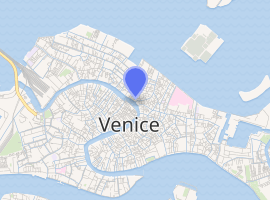Palazzo Michiel del Brusà
Palazzo Michiel del Brusà is a palace located in Venice, more precisely in the Cannaregio district, and overlooking the Grand Canal.[1] The building is located between Palazzo Michiel dalle Colonne and Palazzo Smith Mangilli Valmarana.[2][3]
| Palazzo Michiel del Brusà | |
|---|---|
Palazzo Michiel del Brusà | |

| |
| General information | |
| Type | Office |
| Architectural style | Gothic |
| Address | Cannaregio district |
| Town or city | Venice |
| Country | Italy |
| Coordinates | 45°26′24.7″N 12°20′07.9″E |
| Renovated | 1777 |
| Owner | Global Art Affairs Foundation |
| Technical details | |
| Floor count | 3 |
History
The palazzo was owned by the ancient and noble Michiel family. The family gave three doges to the republic, two of them, Domenico Michiel (1117–1130) and Vitale II Michiel (1156–1172), were forced to abdicate. The word brusà means "burned" in Venetian dialect, because in 1774, the palace was completely devastated by a fire due to the neglect of a maid. Only the original facade on the Grand Canal survived. Three years later, in 1777, the palazzo was rebuilt thanks to funding provided by the city. To commemorate the event, there is the Lain inscription on the facade: "Quos ignis consumpsit patria mementa majorum nepotibus patrios lares restituit s.e. vidus ianuarij 1777."[4]
Today, Palazzo Michiel del Brusà is owned by the Global Art Affairs Foundation, a Dutch non-profit organization involved in the contemporary art and architecture.
Architecture
The main façade is characterized by tripartition and symmetry, which is typical for a Venetian palace. The structure has two noble floors. Important elements of the facade are the two water portals on the ground floor and the quadriforas on the noble floors decorated by the traditional three-lobe Gothic flowers on the point of each arch. The quadriforas are flanked by pairs of single lancet windows on each side. The facade terminates with an attic mezzanine. All openings on the noble floors have projecting balconies and the typical gothic flower on the cusp of the arch. The interiors still preserve rich rooms decorated with stucco and frescos, mostly made by Jacopo Guarana.[5][6]
Gallery
 Internal courtyard
Internal courtyard Fresco with putti in the palazzo
Fresco with putti in the palazzo Entrance
Entrance.jpg) Entrance details
Entrance details Palazzi Michiel dalle Colonne and Michiel del Brusà
Palazzi Michiel dalle Colonne and Michiel del Brusà Grisaille in the palazzo
Grisaille in the palazzo
References
- "Palazzo Michiel del Brusà. Art Destination Venice". universes.art. Retrieved 17 June 2020.
- "Venice Art & Culture". facarospauls.com. Retrieved 17 June 2020.
- Newman, Edward Manuel (1927). Seeing Italy. Funk & Wagnalls Company. p. 316. Retrieved 17 June 2020.
- "Canal Grande di Venezia - Catalogo illustrato - Palazzo Michiel del Brusà". canalgrandevenezia.it. Retrieved 17 June 2020.
- Moretti, Carlo (1872). Venice: Her Art-treasures and Historical Associations. A Guide to the City and the Neighboring Islands, Translated from the First Italian Ed. A. Gerli. p. 76. Retrieved 17 June 2020.
- Calimani, Anna-Vera Sullam; Calimani, Davide (2007). The Grand Canal. Electa. p. 50. Retrieved 17 June 2020.